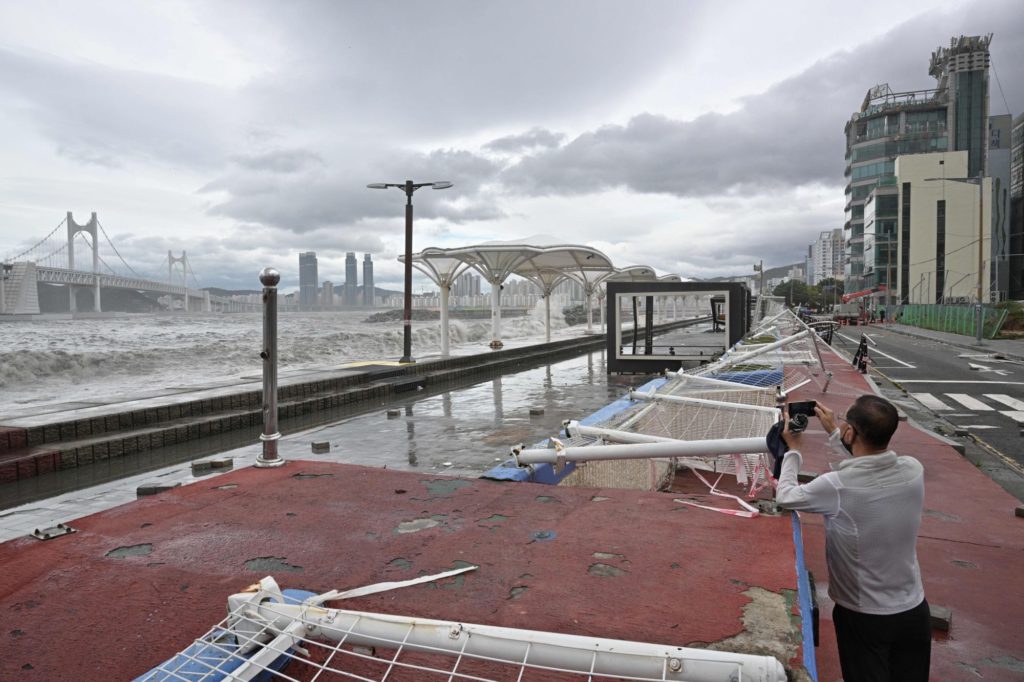Super Typhoon Hinnamnor left a trail of flooding, power outages and disruptions after passing through South Korea early Tuesday, though it delivered less destruction than had been forecast with few early reports of major damage.
(Bloomberg) — Super Typhoon Hinnamnor left a trail of flooding, power outages and disruptions after passing through South Korea early Tuesday, though it delivered less destruction than had been forecast with few early reports of major damage.
Hinnamnor hit near the southern city of Geoje at 4:50 a.m. local time and moved off the coast near Ulsan at 7:10 a.m., the Korea Meteorological Administration said. Projections from the US Joint Typhoon Warning Center show the typhoon moving through Korea’s eastern sea, and potentially making landfall again in eastern Russia.
About 3,500 people were evacuated and 20,000 homes along South Korea’s southern coast line suffered power outages, Yonhap reported. Separately, Posco said a minor fire broke out at two of its plants in the coastal city of Pohang and the company was checking for damages.
Earlier, the meteorological agency had warned of potential casualties from what was expected to be the most powerful storm ever to hit the country. At least one person was reported missing.
Storm’s Impact
Hinnamnor is currently packing sustained winds of about 104 miles (167 kilometers) per hour with gusts around 127 mph, according to the US warning center. While the typhoon is moving away from land, the impact of the massive storm is still being felt across South Korea and even parts of Japan.
Kyushu Electric Power Co., the utility provider for Japan’s southwestern prefectures in Kyushu, said that over 30,000 buildings in the region are without power due to the typhoon, while telecommunications provider KDDI Corp. said service has been disrupted in some parts of the country.
Still, there were signs early Monday that business in South Korea was beginning to return to normal, with buses in Busan and Ulsan scheduled to start operating again during the morning.
Hyundai Motor Co.’s union said the company would resume work before noon while Hyundai Heavy Industries Co. and Daewoo Shipbuilding & Marine Engineering Co. planned to restart in the afternoon. No casualties or damage were reported at the facilities of the automaker and two shipbuilders.
Resuming Flights
Korean Air Lines Co. said it will restart flights to Jeju Island in the morning, while flights to Busan will resume in the afternoon. Asiana Airlines Inc. will resume flights to Jeju after 11 a.m.
Six nuclear reactors on the southeast coast had been running at lower rates ahead of the typhoon. They will operate at a reduced rate for now until the situation returns to normal, according to a spokeswoman at Korea Hydro & Nuclear Power Co.
Read more: Hinnamnor Could Cost Billions as South Korea Braces for Landfall
Oil refiners, chemical operations and the nation’s oldest nuclear power plant had earlier taken precautions amid predictions the typhoon would hammer the resort island of Jeju and the key industrial city of Ulsan on the country’s southeast coast, disrupting ports and air traffic across the region.
The nation suffered the second major storm in a matter of weeks after Seoul was hit by the heaviest rains in a century in early August, killing at least 11 people. President Yoon Suk Yeol faced criticism for his response to the floods and apologized to the nation for “inconveniences” caused by the storm.
Yoon, who earlier promised the government would stay alert to protect the lives and safety of citizens, said Tuesday that while Typhoon Hinnamnor has made its way out to sea, it’s too early to express relief because areas with damage still need to be rescued.
Hinnamnor has already disrupted port operations, airline services and schools across Asia since developing last month. Shanghai’s major container port of Yangshan briefly halted terminal operations. Some schools in both South Korea and China were closed for safety reasons.
More stories like this are available on bloomberg.com
©2022 Bloomberg L.P.











